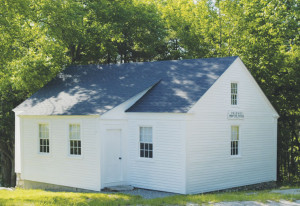
I often have sat silently in the historic Quaker Ridge Meeting House in Casco, Maine, and given thanks that my ancestors settled here long ago, before Maine became a state in 1820. The meetinghouse, which was built in 1814, is the only one I know that is plain on one side of the interior and modernized with church pews and a pump organ on the other. Here is Quaker history in microcosm—especially appropriate in this region of New England Yearly Meeting where programmed and unprogrammed meetings come together in Maine’s Falmouth Quarter.

The first four families to settle along what is now called Quaker Ridge Road were Friends from neighboring town Windham, looking for land to farm. Perhaps the magnificent view to the west (what I’ve come to think of as a “thin place” where heaven and earth draw closer) made them stop and reflect. From this ridge, one can look across valleys and lakes some 50 miles to the White Mountains, with Mount Washington most prominent. Today the highest elevation on Quaker Ridge, known as Hacker’s Hill in memory of Hacker Hall who lived on adjoining land, is protected and preserved for all to enjoy by Loon Echo Land Trust. The meetinghouse is in view below.
At first, Friends met in each other’s homes for worship. But Daniel Cook, one of the first settlers, sold a small corner of his farm close to the road for $5, and there the meetinghouse still stands. It was always a preparative meeting under the care of Windham Meeting. The Maine Historical Society has minute books from Windham Meeting that stretch back 200 years and faithfully record the names of two men and two women from Quaker Ridge who traveled each month for business meetings—now a 20-minute car ride but in the 1800s a significant horse-and-carriage ride—joining with Friends from four other preparative meetings.
As the population of Quakers grew, the meetinghouse was expanded in 1844, and a small stove was added in the center of the larger side. Over the decades, however, the number of Quakers diminished. Farming was hardscrabble, and young people left to seek their fortune elsewhere. The Quaker Ridge Meeting was laid down in 1921, the same year that a fire destroyed the Unity church in the center of Casco, three miles from the Ridge. I surmise that the remnant of Friends decided to support the rebuilding of a community church with their labor, funds, and presence on Sunday mornings, leaving the compact meetinghouse vacant.
In 1956, my aunt, Betsy Maxfield Miller, and her daughter, Sandra, summer residents on Quaker Ridge at the time, reopened the meetinghouse occasionally for worship. Soon, nearby residents Priscilla Rushmore and her son, Jonathan, began attending. Starting in 1957, these four Friends held worship every Sunday in July and August. Windham Friends continued their annual pilgrimage to maintain the building’s tax-exempt status, and Betsy Miller and Hacker Hall established a fund to cover the costs of upkeep and repair.
In 1975, the Quaker Ridge Meeting House was added to the National Register of Historic Places. One of the oldest meetinghouses in Maine, the building is open to visitors from April to October, with unprogrammed worship held at 10:30 a.m. on summer Sundays when anyone is present.
To celebrate the bicentennial of this cherished building, our community gathered on the last Sunday in July this past summer for a service that honored both the programmed tradition of Windham Meeting, as led by lay pastor Janice Beattie, and the unprogrammed silent worship of Daniel Cook and his present-day descendants. Once again I lifted my eyes to the mountains, gave thanks to the ancestors, and rejoiced at the serenity of this “thin place.”









Comments on Friendsjournal.org may be used in the Forum of the print magazine and may be edited for length and clarity.